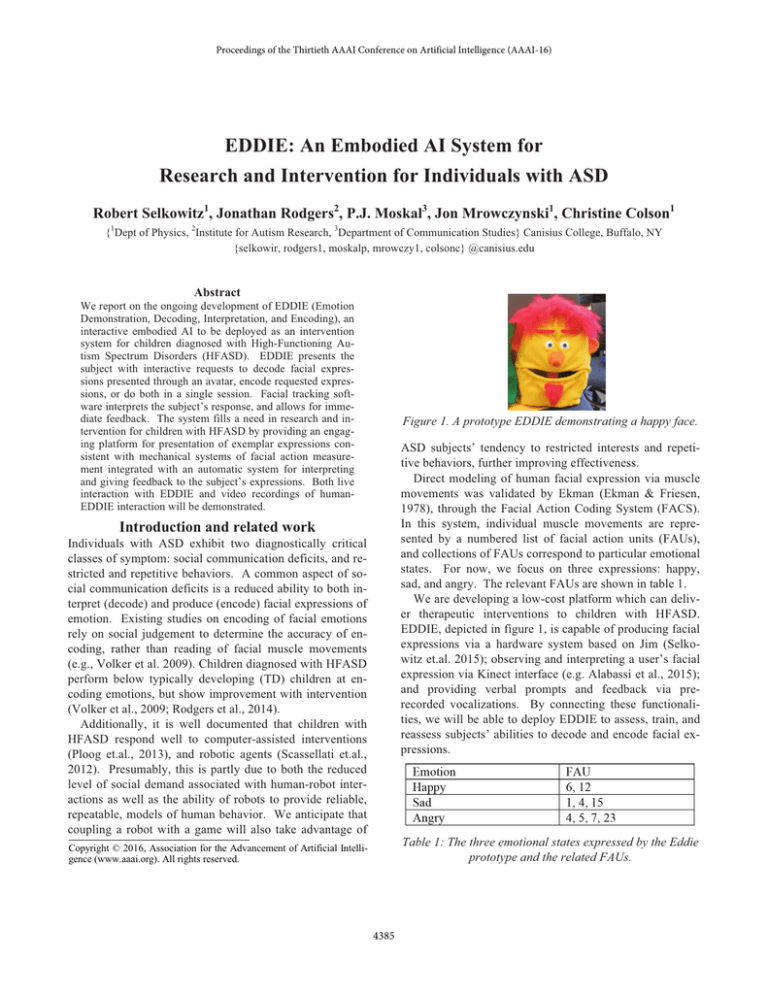
Proceedings of the Thirtieth AAAI Conference on Artificial Intelligence (AAAI-16)
EDDIE: An Embodied AI System for
Research and Intervention for Individuals with ASD
Robert Selkowitz1, Jonathan Rodgers2, P.J. Moskal3, Jon Mrowczynski1, Christine Colson1
{1Dept of Physics, 2Institute for Autism Research, 3Department of Communication Studies} Canisius College, Buffalo, NY
{selkowir, rodgers1, moskalp, mrowczy1, colsonc} @canisius.edu
Abstract
We report on the ongoing development of EDDIE (Emotion
Demonstration, Decoding, Interpretation, and Encoding), an
interactive embodied AI to be deployed as an intervention
system for children diagnosed with High-Functioning Autism Spectrum Disorders (HFASD). EDDIE presents the
subject with interactive requests to decode facial expressions presented through an avatar, encode requested expressions, or do both in a single session. Facial tracking software interprets the subject’s response, and allows for immediate feedback. The system fills a need in research and intervention for children with HFASD by providing an engaging platform for presentation of exemplar expressions consistent with mechanical systems of facial action measurement integrated with an automatic system for interpreting
and giving feedback to the subject’s expressions. Both live
interaction with EDDIE and video recordings of humanEDDIE interaction will be demonstrated.
Figure 1. A prototype EDDIE demonstrating a happy face.
ASD subjects’ tendency to restricted interests and repetitive behaviors, further improving effectiveness.
Direct modeling of human facial expression via muscle
movements was validated by Ekman (Ekman & Friesen,
1978), through the Facial Action Coding System (FACS).
In this system, individual muscle movements are represented by a numbered list of facial action units (FAUs),
and collections of FAUs correspond to particular emotional
states. For now, we focus on three expressions: happy,
sad, and angry. The relevant FAUs are shown in table 1.
We are developing a low-cost platform which can deliver therapeutic interventions to children with HFASD.
EDDIE, depicted in figure 1, is capable of producing facial
expressions via a hardware system based on Jim (Selkowitz et.al. 2015); observing and interpreting a user’s facial
expression via Kinect interface (e.g. Alabassi et al., 2015);
and providing verbal prompts and feedback via prerecorded vocalizations. By connecting these functionalities, we will be able to deploy EDDIE to assess, train, and
reassess subjects’ abilities to decode and encode facial expressions.
Introduction and related work
Individuals with ASD exhibit two diagnostically critical
classes of symptom: social communication deficits, and restricted and repetitive behaviors. A common aspect of social communication deficits is a reduced ability to both interpret (decode) and produce (encode) facial expressions of
emotion. Existing studies on encoding of facial emotions
rely on social judgement to determine the accuracy of encoding, rather than reading of facial muscle movements
(e.g., Volker et al. 2009). Children diagnosed with HFASD
perform below typically developing (TD) children at encoding emotions, but show improvement with intervention
(Volker et al., 2009; Rodgers et al., 2014).
Additionally, it is well documented that children with
HFASD respond well to computer-assisted interventions
(Ploog et.al., 2013), and robotic agents (Scassellati et.al.,
2012). Presumably, this is partly due to both the reduced
level of social demand associated with human-robot interactions as well as the ability of robots to provide reliable,
repeatable, models of human behavior. We anticipate that
coupling a robot with a game will also take advantage of
Table 1: The three emotional states expressed by the Eddie
prototype and the related FAUs.
Copyright © 2016, Association for the Advancement of Artificial Intelligence (www.aaai.org). All rights reserved.
4385
The Systems
We focus here on a few key features of the hardware. We
have replaced Jim’s Lego mechanical parts with 3D printable facial components. These structures allow more reliable articulation, greater strength, and easier distribution
and reproduction. Additionally, minor noise and reliability
issues reported with the Lego motors have been remedied
by switching to servo motors. The MIDI interface has
been retained between EDDIE and the control computer:
the protocol provides timing tools needed to synchronize
movement and vocalization.
The vision system is driven by a single Microsoft Kinect
interface located behind EDDIE’s avatar, roughly 1.0m
from the subject. The Kinect SDK allows for the tracking
of over 100 distinct facial points, and construction of a
mesh consistent with Candide-3. We use changes in the
distances between mesh vertices to infer muscular motions
corresponding to the expression of FAUs. For example,
FAU 4 corresponds to lowering of the eyebrow, a component of angry. We determine the presence of this FAU by
computing the difference in eyebrow location before and
during the expression. If the change exceeds the detection
threshold, the FAU is marked as present. Each FAU is
checked for each expression, and can be compared to table
1. If all FAUs are present, the expression attempt is
marked valid, and encouragement is provided to the subject. If incorrect movements are detected, or expected
movements are missing, EDDIE will vocalize this information as direct feedback to the subject to assist in future
attempts at encoding.
Figure 2. Samples of FAU 4, brow lowerer (left), and neutral (right). Taken from the WSEFEP set (Olszanowski et al., 2015).
cluding anthropomorphized non-humans. Likewise, the
.
proposed game structure is modifiable and customizable,
allowing for a range of custom therapies and studies. A
time table for deployment with HFASD individuals cannot
be determined at this time, but if pilot studies are positive,
further therapy research is anticipated through the Institute
for Autism Research at Canisius College.
In summary, EDDIE is an in-development, low cost,
customizable platform for novel therapies to improve facial
processing of emotion in HFASD subjects. The system
provides three key advantages: objectively-based validation of expression accuracy via FACS; reliable, low-risk
social interaction via a robotic interface; and an underlying
game structure which takes advantage of the characteristics
.
of HFASD subjects to maximize intervention impact
References
Alabbasi, Hesham A., Florica Moldoveanu, and Alin
Moldoveanu. "Real Time Facial Emotion Recognition using Kinect V2 Sensor." IOSR Journal of Computer Engineering (IOSRJCE), Volume 17, Issue 3, Ver. II (May – Jun. 2015), PP 61-68
Ekman, P & Friesen, W. 1978. Facial Action Coding System: A
Technique for the Measurement of Facial Movement. Palo Alto:
Consulting Psychologists Press.
Ploog, B. O., Scharf, A., Nelson, D., & Brooks, P. J. (2013). Use
of computer-assisted technologies (CAT) to enhance social,
communicative, and language development in children with autism spectrum disorders. Journal of Autism and Developmental
Disorders, 43(2), 301-322.
Rodgers, J. D., Thomeer, M. L., Lopata, C., Volker, M. A., Lee,
G. K., McDonald, C. A., Smith, R. A., & Biscotto, A. (2014).
RCT of a psychosocial treatment for children with highfunctioning ASD: Supplemental analyses of treatment effects on
facial emotion encoding. Journal of Developmental and Physical
Disabilities, 2, 207-221. doi: 10.1007/s10882-014-9409-x
Scassellati, B., Admoni, H., & Mataric, M. (2012). Robots for use
in autism research. Annual Review of Biomedical Engineering, 14, 275-294.
Selkowitz, Robert, Michael Heilemann, and Jon Mrowczynski.
"Jim: A Platform for Affective AI in an Interdisciplinary Setting." Fifth AAAI Symposium on Educational Advances in Artificial Intelligence. 2014.
Volker, M. A., Lopata, C., Smith, D. A., & Thomeer, M. L.
(2009). Facial encoding of children with high functioning autism
spectrum disorders. Focus on Autism and Other Developmental
Disabilities, 24, 195-204.
Olszanowski, M., Pochwatko, G., Krzysztof, K., Scibor-Rylski,
M., Lewinski, P., & Ohme, R., (2015). Warsaw set of emotional
facial expression pictures: A validation study of facial display
photographs. Frontiers in Psychology, 5, 1-8. doi:
10.3389/fpsyg.2014.01516
Modes of Operation and Deployment
EDDIE is expected to operate in four modes, each with
possible therapeutic value. In decoding mode, EDDIE will
present the subject with an expression and prompt the subject to provide a verbal interpretation of the expressed
mode. In request encoding mode, EDDIE will verbally request that the subject provide a particular facial expression.
The vision routines will check if appropriate FAUs were
produced by the subject. If so, EDDIE will provide praise.
If not, direct vocalized guidance and simulation on the avatar will be provided. In decode and encode mode, EDDIE
will demonstrate an expression for the subject, and request
verbal decoding as well as mimicry. Feedback will be provided as a combination of that decoding and request encoding modes. In free-form mode, subjects will be prompted
to produce expressions of their choice, and when they
match one of the known emotional states, EDDIE will
mimic it. Periodic feedback will coach subjects away from
mixed or incomplete expressions.
Because it runs on a personal computer, EDDIE is easy
to install and operate. The appearance of EDDIE can be
modified to provide units of any implied age or gender, in-
4386









